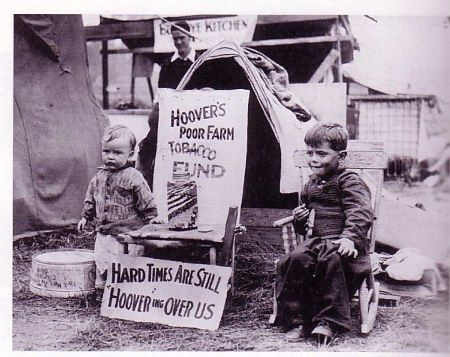The Era of the Great Depression saw the rise of a phenomenon that is unknown to many people today, the "Hooverville." Named after hapless President Herbert Hoover whose presidency was blamed for the bad economy, these shanty towns sprang up in major cities all over the U.S. during the early 1930s.
Hoovervilles were largely populated by families who had been evicted from their homes when husbands had lost their jobs and as a result couldn't pay the mortgage or the property taxes. The country was filled with homeless men without work along with their dependents. Without a permanent roof over their heads, necessity gave birth to the rude, crude squatters' shacks of the Hoovervilles.
The shanties in the Hoovervilles were made up of any material that could be found -- discarded wood, stones, cardboard, tin, tar paper, glass, or canvas. Basically, anything men could move to a spot and use for shelter found a home--built a home!--in the Hoovervilles. Men who were skilled in carpentry and had the wood to work with were able to construct shacks that kept out the rain and cold, but lacking skill or lumber, Hooverville residents used whatever was available to provide shelter from the elements.
As the years dragged on without any improvement in the economy, some Hoovervilles grew larger and took on an air of permanence. "Citizens" organized themselves and tried to work together using their various skills to help each other. Some shantytowns even had their own mayors and sanitary committees.
City governments sometimes tried getting rid of these unsightly suburbs by having the police raid the residents on the excuse of looking for alcohol and illegal activity. When this happened the shanty towns were often burned and their people dispersed. But a new Hooverville would rise in another location as the dislocated relocated--they had no where else to go.
There were no government programs or social "safety net" as we have today that could help the "Hoovervillians" buy food or pay for housing. They were left to their own devices to fend for themselves; many became bitter and angry. The poor and sick felt nothing but hopelessness.
Beginning in 1933, Congress enacted President Franklin Delano Roosevelt's various New Deal programs to help the unemployed and homeless. This helped to improve the conditions that fostered the Hoovervilles, but it took the advent of World War II in 1941 to finally break the back of the seemingly intractable unemployment situation so that the Hoovervilles at last disappeared as the country marched to war.
Our present economic situation is different because of the government programs today that help the poor and homeless. Without these, it would be likely that we would see more 21st century shanty towns since the unemployment rate is still so high. But it all comes at a price: our national debt is soaring and a mentality that looks to the government to solve all problems and support all needs is growing. Still, here's hoping that we don't ever "waste away again in 'Hoovervilles'"!
Information for this article taken from : United States History website

No comments:
Post a Comment